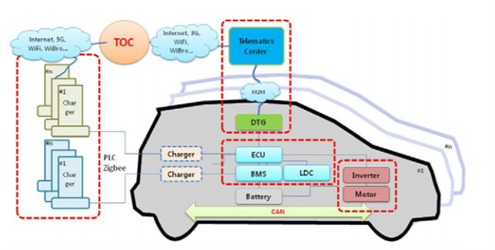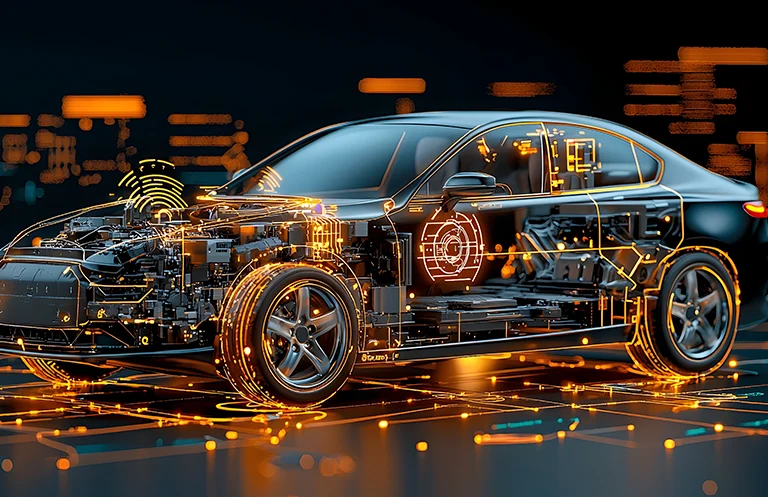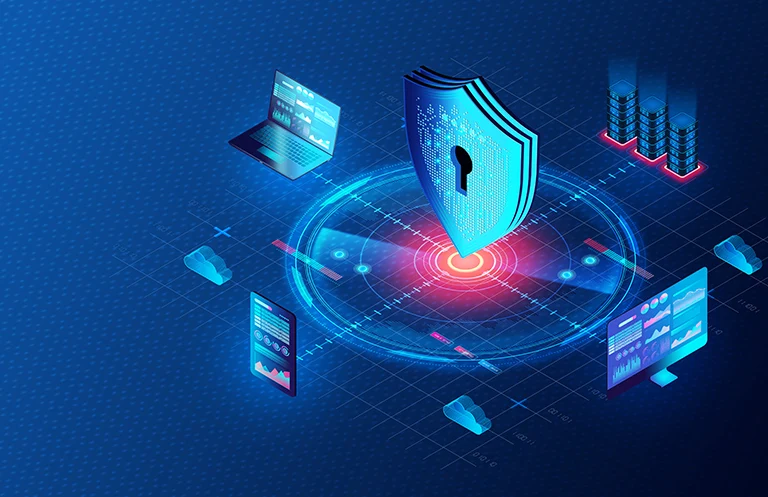“In the era of connected technology,” every technology-driven business is talking about various use cases and new trends of IoT and connected applications within different industry paradigms. Considering the automotive sector- it has been an industry-altering technology advancement in this era, which is gathering the attention of researchers, tech-savvy personals, and many start-ups who are seeking rapid digital transformation.
What data does EV telematics Give?
Electric vehicle telematics systems instantly give fleet managers an abundance of knowledge, information, and a thorough understanding of their EV fleets. This contains everything from existing battery capacity and discharge rates to the distances your drivers take and how effectively they drive. A trustworthy electric car telematics system allows you to track a variety of driving parameters, including hard braking, current and average speed, and quick acceleration.
How does an electric vehicle’s telematics system work?
EV telematics combines cloud-based technologies and in-vehicle technology. Although no two telematics devices are exactly alike, the physical component is commonly inserted into the car or attached to the vehicle’s diagnostic link and then collects and sends data to a cloud-based system via a mobile Internet network. Fleet managers can then view the data through an online dashboard. They will be able to examine extensive reports on performance metrics over time and in real-time and utilize them to affect crucial decision-making and route scheduling, among other things.
Current Trends
There has been technological advancement in this paradigm when companies started working with integration of sensors and connectivity protocols and then it headed towards current trends like Autosar, ADAS, Advanced Telematics, Infotainment systems, Autonomous Vehicles, and Electric Vehicles (EV). Some of these technologies have become an important part of most of the vehicles in the automotive world, now. The current growing segment in the automotive segment is the Autonomous and Electric Vehicles. Both areas have different levels of success where the electric vehicle segment is growing rapidly. In 2019, the market size for EV was USD 413.1 million and it is projected to reach 1095.4 million by 2027 with a growth rate of 20.3% (Fortune Business Insight, 2020).
What does Telematics mean in Vehicle?
Automotive telematics is the continuous monitoring of a motorized fleet using GPS systems, onboard diagnostics, telecommunications and informatics (‘telematics’), vehicular technology, and the Internet of Things (IoT). By using automotive telematics, fleet supervisors can collect important data and develop a better understanding of their fleets, ultimately enhancing vehicle efficiency and driver safety.
EV telematics is a combination of automobile telematics systems in electric fleets. EV telematics helps fleet managers run more efficient fleets while also adjusting to the inevitable changes that will occur as the number of electric vehicles grows.
Why EV Telematics is Important?
The basic advantages of EV vehicles are the low cost of ownership- the electricity to run an EV for one-kilometer costs one third of running a petrol vehicle for the same distance, low cost of maintenance- EV has fewer moving parts than a conventional fuel vehicle, and EVs are better for the environment- emission reduction (Ergon, 2020).
An electric vehicle owner needs to understand when and where they can charge the vehicle on the run. Most hybrid vehicle owners end up using gasoline more due to the unavailability of information on a battery charge, which does not fulfill the basic advantage of EV vehicles. Ergo, many countries are developing nationwide charging station infrastructure so EV users can get the ease of battery charge. This will also provide communication between the power grid and Vehicle (V2G), so users have access to the peak load hours, and they can utilize the grid power according to the peak charges schedule to reduce charging cost. “For better deployment EVs and charge services, telematics technology is essential, as it provides useful information.

the exchange between a car on the move and the service of interest via the wireless network” (Kim, T. et al., 2011, pp. 177) In addition to that EV telematics enables many services such as traffic information, pathfinder, online booking for charging spots, remote diagnostics, battery life, battery charging status, and notification for the time remaining for next charge.
What data does EV telematics Give?
Electric vehicle telematics systems instantly give fleet managers an abundance of knowledge, information, and a thorough understanding of their EV fleets. This contains everything from existing battery capacity and discharge rates to the distances your drivers take and how effectively they drive. A trustworthy electric car telematics system allows you to track a variety of driving parameters, including hard braking, current and average speed, and quick acceleration.
How does an electric vehicle’s telematics system work?
EV telematics combines cloud-based technologies and in-vehicle technology. Although no two telematics devices are exactly alike, the physical component is commonly inserted into the car or attached to the vehicle’s diagnostic link and then collects and sends data to a cloud-based system via a mobile Internet network.
Fleet managers can then view the data through an online dashboard. They will be able to examine extensive reports on performance metrics over time and in real-time and utilize them to affect crucial decision-making and route scheduling, among other things.
Benefits of EV Telematics
1. Navigation and Tracking system
One of the basic applications for EV telematics is the live map updates. It provides details on the real-time location of EV vehicle on a digital map. This navigation system works on GPS, which helps in tracking the location of the vehicle and sends data via connectivity protocols like Wi-Fi, 4G, LTE, and CDMA, etc. for remote access. This map helps in getting the real-time traffic situation on the road so the user can set the best route to the destination to save average energy consumption with a reduction in total distance traveled. The Pathfinding system of telematics calculates the distance a vehicle will travel and provides analysis on the required charging for batteries while recommending a travel route that has a charging station available for re-charging.
2. Charging Methods
Many organizations and researchers are working towards the advancement of EV in terms of reducing the charging time, cost, battery size, and weight. Charging an EV might take more time if the energy requirement is high for a particular vehicle (Depending on battery size) so the availability of a charging station is essential for EV. Therefore, EV telematics runs algorithms like Dijkstra to find out the optimal place for charging the vehicle while accounting for the current battery charge status and the distance a vehicle can travel. The Telematics system automatically sends the charging spot request to the nearest station to check if they can fulfill the requirement on top of the previously scheduled charging spots. Also, the system displays the vehicle’s state of charge (SOC) so the user can plan trips accordingly.
3. Driving Analysis
EV telematics gathers the data from DTG (Digital Tachometer Graph) and GPS to depict the state of the vehicle in terms of distance traveled, time taken, over speeding during the journey, malfunctioning, records the exceptional events, and warnings. As per the above discussion, telematics provides the best route for travel and by comparing the driving analysis data it refines the result for better route optimization, provides warnings on exceeding the driving speed limit, and vehicle services status.
Conclusion
Telematics plays an important part in many levels for an electric vehicle. eInfochips an Arrow company is helping OEMs in developing charging station infrastructure and best in industry telematics solutions by covering all the aspects of end-to-end development from hardware, firmware, software, and cloud applications. eInfochips has expertise in providing the best in industry AI-based Driver Behavior System, Video Analytics, Fleet Tracking, Remote Diagnostics, Predictive Maintenance, and Navigation System Integration for Electric Vehicles. To know more about Electric Vehicle Telematics, please connect with our experts today
References:
• Kim, T. et al., 2011. Advanced Communication and Networking : International Conference, ACN 2011, Brno, Czech Republic, August 15-17, 2011, Proceedings 1st ed. 2011. Berlin, Heidelberg: Springer Berlin Heidelberg : Imprint: Springer. Pp. 177, available at: https://link.springer.com/chapter/10.1007/978-3-642-23312-8_21
• Fortune Business Insight,2020, Electric Vehicle Telematics Market Size, Share & Forecast, Available at: https://www.fortunebusinessinsights.com/industry-reports/electric-vehicle-telematics-market-101655, Accessed on 11/05/2020
• Ergon Energy, 2020. Benefits of electric vehicles, Available at: https://www.ergon.com.au/network/smarter-energy/electric-vehicles/benefits-of-electric-vehicles












